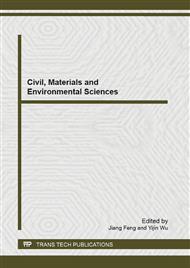p.209
p.215
p.220
p.224
p.231
p.237
p.243
p.249
p.257
Studies of Mechanical Properties and Absorption of Lightweight Concrete with Brazilian Expanded Clay
Abstract:
Brazilian Expanded Clay. The production process in a rotary kiln (or nodule) used in Brazil, characterized by the fact that certain materials expand when subjected to high temperatures (between 1000 °C and 1350 °C), such as some clays. In this temperature range, some of the material melts generating a viscous mass, while the other part chemically decomposes releasing gases which are incorporated by this mass, expanding by up to seven times its initial volume, the pore structure being maintained after its cooling. This manufacturing process promotes the formation of a glazed layer on the outside with low particle porosity, which significantly reduces the water absorption, has varying particle size and regular rounded shape, and its specific gravity comprised within the range from 0.64 to 1.51 kg/dm3 [4, .
Info:
Periodical:
Pages:
231-236
Citation:
Online since:
August 2013
Price:
Сopyright:
© 2013 Trans Tech Publications Ltd. All Rights Reserved
Share:
Citation:


